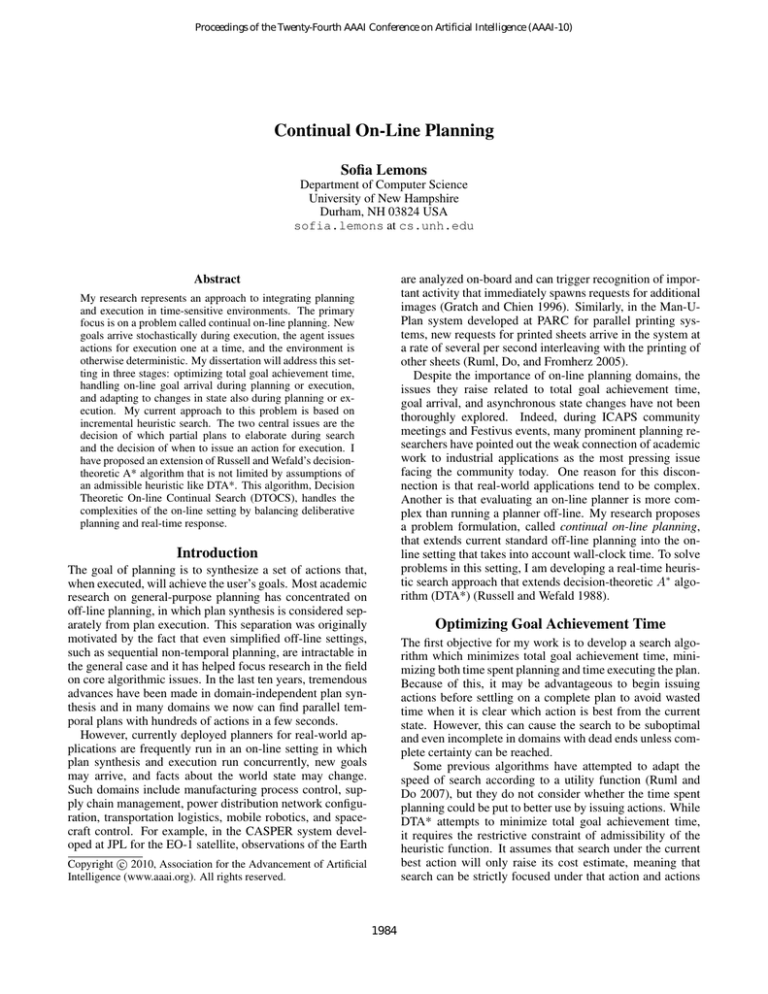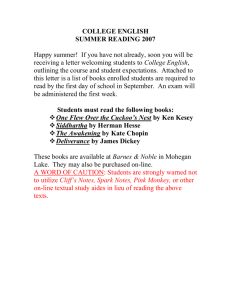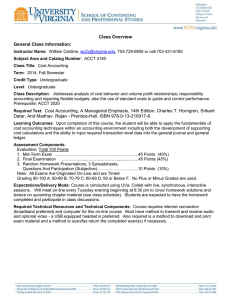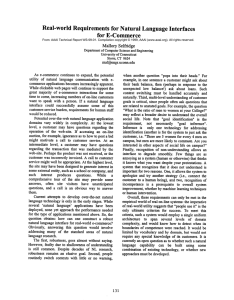
Proceedings of the Twenty-Fourth AAAI Conference on Artificial Intelligence (AAAI-10)
Continual On-Line Planning
Sofia Lemons
Department of Computer Science
University of New Hampshire
Durham, NH 03824 USA
sofia.lemons at cs.unh.edu
Abstract
are analyzed on-board and can trigger recognition of important activity that immediately spawns requests for additional
images (Gratch and Chien 1996). Similarly, in the Man-UPlan system developed at PARC for parallel printing systems, new requests for printed sheets arrive in the system at
a rate of several per second interleaving with the printing of
other sheets (Ruml, Do, and Fromherz 2005).
Despite the importance of on-line planning domains, the
issues they raise related to total goal achievement time,
goal arrival, and asynchronous state changes have not been
thoroughly explored. Indeed, during ICAPS community
meetings and Festivus events, many prominent planning researchers have pointed out the weak connection of academic
work to industrial applications as the most pressing issue
facing the community today. One reason for this disconnection is that real-world applications tend to be complex.
Another is that evaluating an on-line planner is more complex than running a planner off-line. My research proposes
a problem formulation, called continual on-line planning,
that extends current standard off-line planning into the online setting that takes into account wall-clock time. To solve
problems in this setting, I am developing a real-time heuristic search approach that extends decision-theoretic A∗ algorithm (DTA*) (Russell and Wefald 1988).
My research represents an approach to integrating planning
and execution in time-sensitive environments. The primary
focus is on a problem called continual on-line planning. New
goals arrive stochastically during execution, the agent issues
actions for execution one at a time, and the environment is
otherwise deterministic. My dissertation will address this setting in three stages: optimizing total goal achievement time,
handling on-line goal arrival during planning or execution,
and adapting to changes in state also during planning or execution. My current approach to this problem is based on
incremental heuristic search. The two central issues are the
decision of which partial plans to elaborate during search
and the decision of when to issue an action for execution. I
have proposed an extension of Russell and Wefald’s decisiontheoretic A* algorithm that is not limited by assumptions of
an admissible heuristic like DTA*. This algorithm, Decision
Theoretic On-line Continual Search (DTOCS), handles the
complexities of the on-line setting by balancing deliberative
planning and real-time response.
Introduction
The goal of planning is to synthesize a set of actions that,
when executed, will achieve the user’s goals. Most academic
research on general-purpose planning has concentrated on
off-line planning, in which plan synthesis is considered separately from plan execution. This separation was originally
motivated by the fact that even simplified off-line settings,
such as sequential non-temporal planning, are intractable in
the general case and it has helped focus research in the field
on core algorithmic issues. In the last ten years, tremendous
advances have been made in domain-independent plan synthesis and in many domains we now can find parallel temporal plans with hundreds of actions in a few seconds.
However, currently deployed planners for real-world applications are frequently run in an on-line setting in which
plan synthesis and execution run concurrently, new goals
may arrive, and facts about the world state may change.
Such domains include manufacturing process control, supply chain management, power distribution network configuration, transportation logistics, mobile robotics, and spacecraft control. For example, in the CASPER system developed at JPL for the EO-1 satellite, observations of the Earth
Optimizing Goal Achievement Time
The first objective for my work is to develop a search algorithm which minimizes total goal achievement time, minimizing both time spent planning and time executing the plan.
Because of this, it may be advantageous to begin issuing
actions before settling on a complete plan to avoid wasted
time when it is clear which action is best from the current
state. However, this can cause the search to be suboptimal
and even incomplete in domains with dead ends unless complete certainty can be reached.
Some previous algorithms have attempted to adapt the
speed of search according to a utility function (Ruml and
Do 2007), but they do not consider whether the time spent
planning could be put to better use by issuing actions. While
DTA* attempts to minimize total goal achievement time,
it requires the restrictive constraint of admissibility of the
heuristic function. It assumes that search under the current
best action will only raise its cost estimate, meaning that
search can be strictly focused under that action and actions
c 2010, Association for the Advancement of Artificial
Copyright Intelligence (www.aaai.org). All rights reserved.
1984
1. while the utility of search > 0
2. action ← select action to search
3. repeat k times
4. if a new goal has arrived, then
5.
clear the open list and go to line 1
6. if real time has reached the time stamp of the root, then
7.
prune everything except the subtree under the
advance time top-level action
8.
go to line 1
9. expand the best node under action
known (or estimated on-line), we want to be able to plan for
the future, acting in a way that anticipates any likely future
goal arrivals. The agent does so by generating sampled futures using the arrival probability, allowing it to deal with a
determinized version of the problem. These samples are created by projecting into the future out to a given horizon, with
possible goal arrivals and the times at which they are imagined to have arrived. Planning can then be done for these
samples to determine the value of each action. I am collaborating with the creators of an “anticipatory” algorithm for
handling on-line goal arrival (Hubbe et al. 2008) and will
extend upon their work by generating a single plan for all
sampled futures (rather than a plan for each sample), allowing work to be reused after each action is issued.
Figure 1: The pseudocode for DTOCS
can be issued when the agent is fairly certain that its value
will not increase to more than the second-best action’s. An
inadmissible heuristic, however, means that search under an
action could either raise or lower its estimated cost, requiring the agent to make more complex decisions about where
to focus search and when to issue actions.
My proposed algorithm, called Decision Theoretic Online Continual Search (DTOCS) (Lemons et al. 2010), is
capable of using a heuristic function which is not strictly
optimistic by measuring the total uncertainty in the believed
value of actions. It attempts to decide whether to continue
searching or issue the action that appears to be the best. As
mentioned above, the objective is to minimize the actual
time spent for both planning and executing (in addition to
minimizing action cost.) Given this novel objective function,
the expansion order for nodes during search can not be based
solely on the estimated cost of solutions under that particular node. Instead, nodes should be given priority based on
the information gained by expanding them. The information
that is most important in this setting is which action from our
current state lies on the path to a better solution than the others. We want to expand nodes which will decrease our uncertainty about which action is best. Uncertainty in this case
must be expressed as a function of heuristic error, allowing
the agent to estimate the probability of belief over action
values changing in a significant way should more search be
performed. Pseudocode for DTOCS is given in Figure 1.
Asynchronous State Changes
To extend my work to an even more general case, I will work
on the problem of state changes outside the agent’s control during search. Work on adapting to changing goal sets
should provide insight into the problem of changing state.
This feature can be viewed, much like goals, as the arrival of
new facts according to some probability function. It is general enough to encompass several other interesting features
often ignored by traditional planning, such as arriving goals
which affect action applicability or even action failure. This
work will also be centered around methods of determinizing the problem and attempting to predict future outcomes
using sampling. However, the planning methods discussed
will not be directly applicable because an existing plan can
be made invalid by the arrival (whether predicted or real) of
new facts. My work will have to find ways of planning that
are robust to these changes.
References
Benton, J.; Do, M. B.; and Ruml, W. 2007. A simple testbed
for on-line planning. In Proceedings of the ICAPS-07 Workshop on Moving Planning and Scheduling Systems into the
Real World.
Gratch, J., and Chien, S. 1996. Adaptive problem-solving
for large-scale scheduling problems: A case study. Journal
of Artificial Intelligence Research 4:365–396.
Hubbe, A.; Ruml, W.; Yoon, S.; Benton, J.; and Do, M. B.
2008. On-line anticipatory planning. In Proceedings of the
ICAPS-08 Workshop on A Reality Check for Planning and
Scheduling Under Uncertainty.
Lemons, S.; Benton, J.; Ruml, W.; Do, M.; and Yoon, S.
2010. Continual on-line planning as decision-theoretic incremental heuristic search. In Proceedings of the AAAI 2010
Spring Symposium on Embedded Reasoning.
Ruml, W., and Do, M. B. 2007. Best-first utility-guided
search. In Proceedings of IJCAI-07, 2378–2384.
Ruml, W.; Do, M. B.; and Fromherz, M. P. J. 2005. On-line
planning and scheduling for high-speed manufacturing. In
Proceedings of ICAPS-05, 30–39.
Russell, S., and Wefald, E. 1988. Multi-level decisiontheoretic search. In Proceedings of the AAAI Symposium
on Computer Game-Playing.
On-line Goal Arrival
The next objective for my research is to handle the arrival
of additional goals during planning and execution. Work
on non-decreasing heuristic functions will help in this endeavor because goal arrivals, regardless of the admissibility of the heuristic for a static set of goals, can increase reward obtained by a plan. I assume that goal arrival does
not change the state in terms of the applicability of actions,
meaning that the existence or non-existence of a goal does
not invalidate an existing plan, although it may change its
reward value. Much like traditional planning, action results are deterministic, as opposed to settings in which executed actions may fail to achieve some or all of their postconditions or cause additional effects beyond what was expected. One could simply synthesize a complete plan for
the current set of goals, replanning whenever new goals arrive (Benton, Do, and Ruml 2007; Gratch and Chien 1996;
Ruml, Do, and Fromherz 2005), but the complexity of complete plan synthesis can delay the start of action execution.
Because we assume that the goal arrival distribution is
1985




